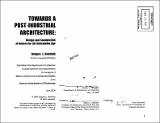Towards a post-industrial architecture : design and construction of houses for the information age
Author(s)
Demchak, Gregory L. (Gregory Leonard), 1974-
DownloadFull printable version (33.52Mb)
Other Contributors
Massachusetts Institute of Technology. Dept. of Architecture.
Advisor
William J. Mitchell.
Terms of use
Metadata
Show full item recordAbstract
The design and construction of modern residential architecture, which came into critical focus by architects of the Machine Age, continues to be a priority in the architectural discourse. For Modern architects, the desire to relate the house to industrial processes was an aesthetic and social imperative that never gained popular acceptance. Today, mention of an industrial, factory-produced house conjures images of mobile homes and cheap construction rather than innovative modern design. At the same time, the typical suburban single-family unit offers little in the way of innovation or individual expression. Land developers, rather than architects or planners, have taken control of the residential market, and do not offer architectural design services to average consumers. As a result, the design of homes adheres to generic standards that are neither flexible nor adaptable to changing family and individual needs. Stylistic choices are extremely limited. The topic of this thesis is to address these and other issues currently impeding the development of innovative residential architecture by exploring the use of computational tools to generate unique architectural solutions. Strategies for obtaining meaningful information from clients that generate spatial rules are explored, as well as a construction methodology that supports multivalent, adjustable architecture.
Description
Thesis (S.M.)--Massachusetts Institute of Technology, Dept. of Architecture, 2000. Includes bibliographical references (p. 132-137).
Date issued
2000Department
Massachusetts Institute of Technology. Department of ArchitecturePublisher
Massachusetts Institute of Technology
Keywords
Architecture.